The 72nd Rolex-Sydney-Hobart gets under way on Monday. The Australian ocean classic is rightly regarded as a tough event. Yet in terms of the sailing challenges its poses, it seems to pale into insignificance when set against the Everest of ocean racing, the Vendee Globe. But W M Nixon wonders if it’s fair on either event to try to make meaningful comparisons.
Just ten days ago on December 14th, the IMOCA 60 St Michel-Virbac, racing in the Vendee Globe Race, came speeding through the Bass Strait between Tasmania and mainland Australia, eastward bound for Cape Horn. Her skipper Jean-Pierre Dick – who won the 2007-2008 Barcelona World race as co-skipper with Ireland’s Damian Foxall – was seeking some shreds of shelter from a huge storm raging in the Great Southern Ocean between Tasmania and Antarctica.
It is the first time in the history of the Vendee Globe that a boat has diverted so far north and used the channel between Tasmania and Australia. But then, under the ice-avoiding conditions stipulated for the current edition of the race, the whole fleet has probably been further north than it might have been in time past.
Be that as it may, when this race is over the analysts will debate whether or not St Michel-Virbac gained or lost from her tactic. For now, all we know is that she currently lies fourth overall, having moved up a place when the Marcus Hutchinson-managed Paul Meilhat of SMA had to pull out with a catastrophic keel mechanism ram failure on Wednesday December 21st. So the probability is that by easing up on the pressure, albeit briefly, St Michel-Virbac did herself no harm at all in the big picture.
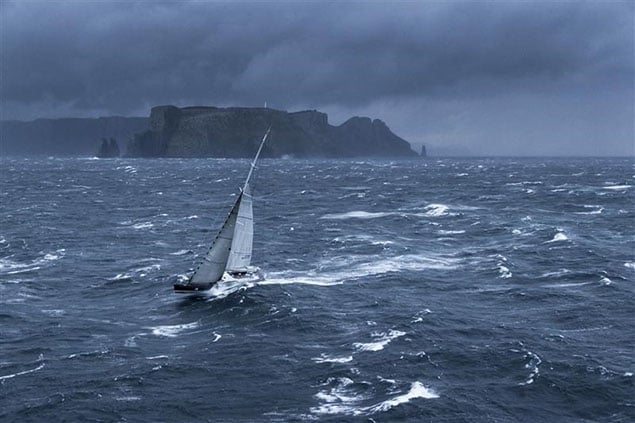 The waters of Tasmania in an unruly mood – the Swan 82 Nikata in the 2013 Rolex Sydney-Hobart Race. Photo Rolex
The waters of Tasmania in an unruly mood – the Swan 82 Nikata in the 2013 Rolex Sydney-Hobart Race. Photo Rolex
 Kilcullen Voyager may look ultra-modern to many sailors, yet she’s a ten year old veteran which lacks the hydrofoils of the most modern boats. Photo Team Ireland
Kilcullen Voyager may look ultra-modern to many sailors, yet she’s a ten year old veteran which lacks the hydrofoils of the most modern boats. Photo Team Ireland
As for Marcus Hutchinson, his challenges these past few days have been prodigious. Not only is he Race Director for the SMA team, but he and his colleagues have been giving a friendly hand to the much less heavily-resourced Team Ireland campaign which is doing what it can to keep the Enda O Coineen show on the road with the ten-year-old Kilcullen Voyager.
In fact, the two boats are light years apart, as SMA is one of the newest boats with hydrofoils (all five current leaders are so equipped, even if second-placed Alex Thomson Hugo Boss has lost his starboard foil), whereas Kilcullen Voyager is an old Mike Golding warhorse which has been round the block and then some.
 Paul Meilhart’s SMA has Marcus Hutchinson as Race Director, but after a very successful first half of the Vendee Globe, Meilhart is now out with a failed keel ram. Photo: Vendee Globe
Paul Meilhart’s SMA has Marcus Hutchinson as Race Director, but after a very successful first half of the Vendee Globe, Meilhart is now out with a failed keel ram. Photo: Vendee Globe
Yet now SMA is out of the race and the problem is to provide a rendezvous for her with a replacement keel ram which can be modified to fit her particular setup. But the doughty 60-year-old Enda O Coineen is still on track and moving steadily up the rankings despite setbacks which would have put many others out of contention.
The risks he’s had to take to keep it going defy the imagination. A sheet got well and truly fouled around one of his twin rudders, which meant he had to set the boat sailing on track such that the rudder was clear of the water on the weather side, and then he’d to clamber over that same wet and heaving side of the boat and perch on the rudder while he cleared the line.
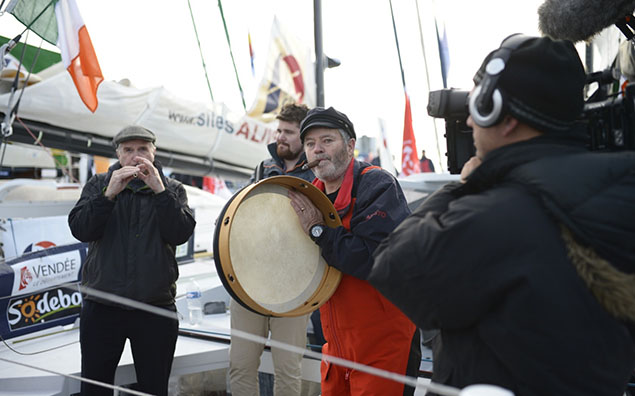 The party animal….Enda O Coineen with bodhran and cigar in Les Sables d’Olonne before the start
The party animal….Enda O Coineen with bodhran and cigar in Les Sables d’Olonne before the start
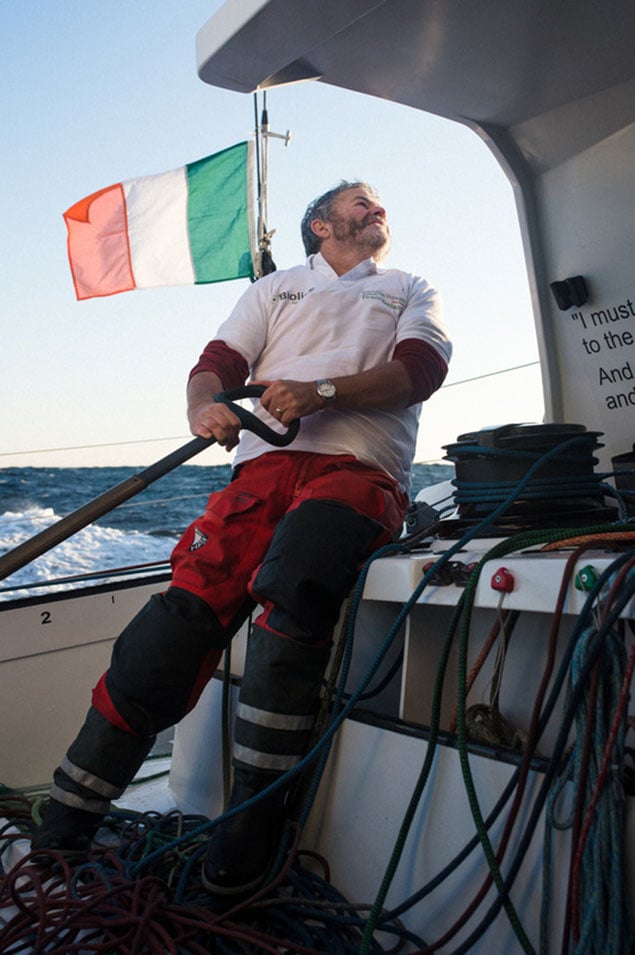 On his own, but the going is good. Enda O Coineen aboard Kilcullen Voyager getting the sort of sailing most of us dream of.
On his own, but the going is good. Enda O Coineen aboard Kilcullen Voyager getting the sort of sailing most of us dream of.
Even he admitted that he suffered a bit of a reaction to the all-or-nothing situation he had been in once he got safely back on deck. But since then his race has literally entered a darker phase as a massive knockdown has blanked out much of his electronics and knocked out his computer with the screen filled with water.
Even ashore in a fully-equipped workshop you’d be hard put to set that right. But in washing machine mode at top cycle, it’s a genius-defying predicament, yet his main men on land - Neil O’Hagan with Marcus Hutchinson - are doing everything possible while Marcus at the same time is seeing through the support programme for Paul Meilhart and the crippled SMA.
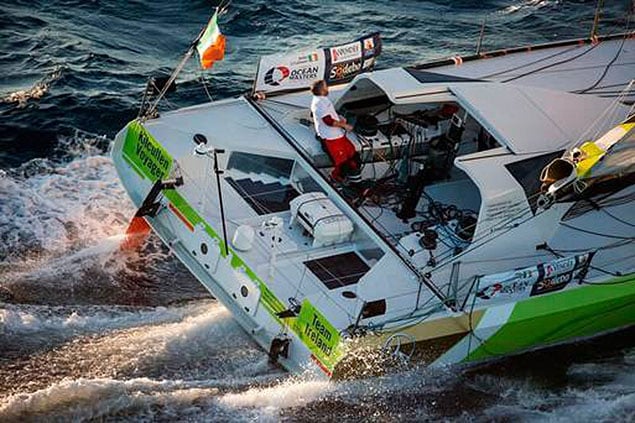 Aboard Kilcullen Voyager, the lone skipper has had a best day’s run of 395 miles. But now after electronic damage following a knockdown, he is back to basics with a small GPS and paper charts.
Aboard Kilcullen Voyager, the lone skipper has had a best day’s run of 395 miles. But now after electronic damage following a knockdown, he is back to basics with a small GPS and paper charts.
For Enda, it has been back to paper charts, a small GPS, and eyeball navigation with very red eyeballs. But by yesterday he was south of Australia, lying 13th overall out of 29 starters, and later today he hopes to be passing well south of Tasmania. Meanwhile in Sydney the crew of 88 boats will be having very controlled Christmas festivities as they keep themselves in competition-ready condition for the lunchtime start of the Rolex Sydney-Hobart Race on December 26th, with Tasmania and the Bass Strait very much in mind.
Back on December 14th, it was difficult to resist the temptation to draw smart-ass comparisons between the fact that a single-handed skipper racing in the Vendee Globe came whizzing through the Bass Strait for a brief experience of easier going, yet just two weeks later the crews the Hobart dash – the 72nd - reckon they’re the hard men (and women), and then some, to be facing into the crossing of the same Bass Strait.
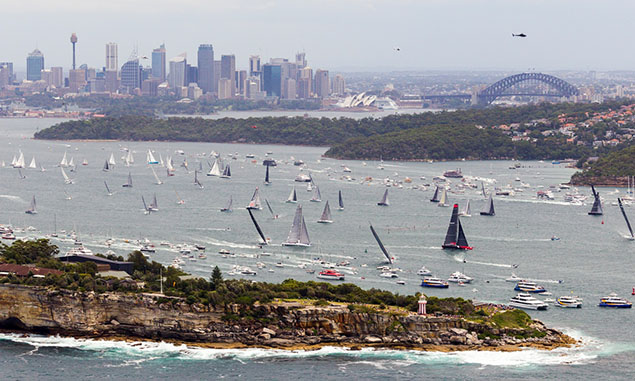 It’s an evocative part of world sailing’s fabric – the classic start of the Rolex Sydney-Hobart Race, down the harbour and out into the Tasman Sea. Photo Carlo Borlenghi/Rolex
It’s an evocative part of world sailing’s fabric – the classic start of the Rolex Sydney-Hobart Race, down the harbour and out into the Tasman Sea. Photo Carlo Borlenghi/Rolex
 The race to Hobart as popularly imagined – slugging it out across the Bass Strait. Photo Rolex
The race to Hobart as popularly imagined – slugging it out across the Bass Strait. Photo Rolex
But apart from the geographic proximity, comparisons are scarcely valid. The Rolex Sydney-Hobart Race is a 630-mile sprint in which mostly amateur crews endure oceanic conditions of all kinds for a relatively brief period of sometimes very scary stuff, knowing that at any time a port is within a day’s sail provided their boat hasn’t been totally incapacitated.
That said, people have been lost racing to Hobart, with six being drowned in 1998’s race when a storm swept through the Bass Straits. But it was a disaster from which much was learned and is unlikely to be repeated, even though the sudden changeability of the weather in the course region, despite it being the Australian summer, is something more extreme than in most European experience.
Nevertheless, the Vendee Globe, despite its huge media machine and technically savvy shore support teams, ultimately comes down to just one lone sailor racing an enormous and demanding machine with sails of a size which in times past would have been considered unthinkable as a solo command.
Admittedly when in the region of Tasmania, these skippers are mostly sailing downwind, whereas the crews racing to Hobart can expect a windward slugging match. But in the mighty flowing tapestry which is the weather of the Great Southern Ocean, every so often the approach of yet another low pressure system will force the Vendee Globe Skippers to put in some harsh windward work before the fronts sweep through and they can get back to the business of fast offwind sailing which recently has seen the race leaders pass Point Nemo, that imaginary spot in the Southern Ocean way south of the Pacific which is the furthest possible point on the planet from the nearest land – 1,670 miles.
That’s a helluva sight further from the nearest land than you’ll be when sailing in the Bass Strait, where Jeanne-Pierre Dick reported on his culture shock - after so many days of lone sailing on open ocean - at seeing evidence of habitation in the form of wind turbines. With all due respect to the skipper of St Michel-Virbac, most of us experience culture shock at seeing a formerly-beloved landscape suddenly polluted with wind farms, but we know what he meant.
Be that as it may, the very thought of Point Nemo is enough to give your ordinary human being the frights, but the Vendee Globe racers have to take it in their stride, in fact they scarcely notice it as the main points are the real land ones, with Cape Horn in all its notorious glory now coming centre stage.
On Monday, there’ll be 88 boats coming centre stage in the natural amphitheatre of Sydney Harbour, and with the time of year that’s in it, the Rolex Sydney-Hobart Race is one of the most keenly-followed sailing classics in the world for the simple reason that most of the world’s sailing population lives in the northern hemisphere, and it offers a wonderful escape from the rigours of a winter Christmas.
 The First 40 Breakthrough will have Ireland’s Barry Hurley as Sailing Master in Monday’s Rolex Sydney-Hobart Race
The First 40 Breakthrough will have Ireland’s Barry Hurley as Sailing Master in Monday’s Rolex Sydney-Hobart Race
There’s considerable Irish interest – after all, ex-Pat Gordon Maguire has won it twice – but as well there’s a natural fascination with the comparision of the performance of different boat types in what amounts to full-size laboratory conditions.
Last time round, Maguire’s owner Matt Allen put himself in the tricky position of having to choose at the last minute between taking his Carkeek 60 Ichi Ban or his TP 52 of the same name – both were race ready with days to go. In the end they plumped for the Carkeek, and she had a reasonably good race. But the irony of it all was that the overall winner was the 2008-vintage TP 52 Balance, owned by Australia’s popular financial guru Paul Clitheroe.
He’s probably extra-busy these days guiding people through Australia’s current mini-recession, which has the entry down to 88 boats. If this trend continues, in the foreseeable future the Volvo Round Ireland Race, with its entry numbers rising to 63 in 2016, could be matching the Rolex Sydney-Hobart in fleet size, which really would be one for the books.
But that’s another day’s work. Right now, we can find Irish interest in Sydney in Gordon Maguire as sailing master aboard the TP52 Ichi Ban, in Barry Hurley of Malta but still Royal Irish YC in his CV as Sailing Master of the First 40 Breakthrough with Kenneth Rumball in the crew, and in Shane Diviney, originally of Howth but getting up to speed these days with the professional multi-hull scene Down Under, who is a crew-member aboard the successful Judel Vrolik 62 Chinese Whispers.
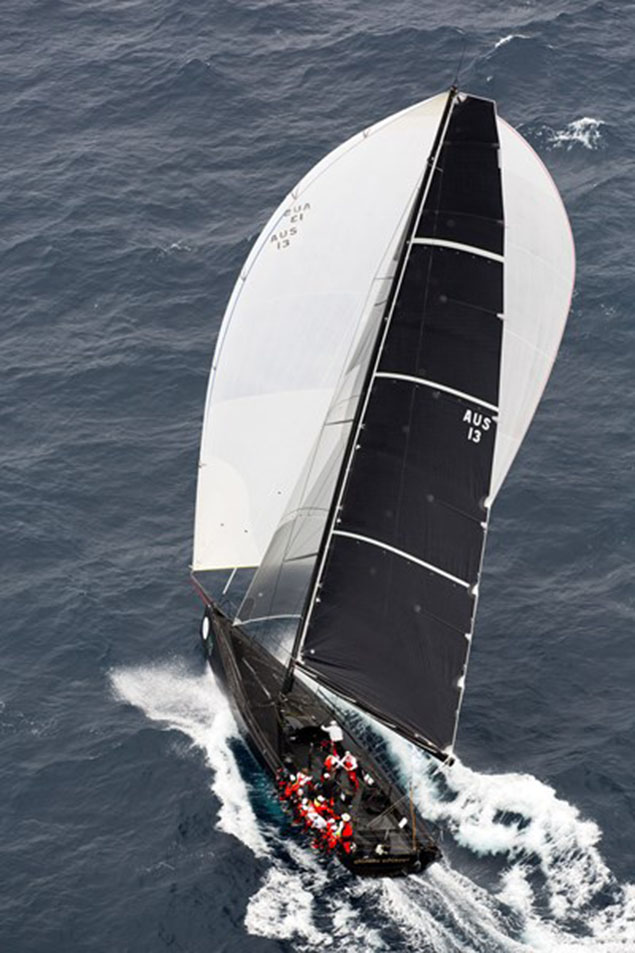 The successful JV62 Chinese Whispers has Ireland’s rising star Shane Diviney in her crew for the Rolex Sydney-Hobart Race.
The successful JV62 Chinese Whispers has Ireland’s rising star Shane Diviney in her crew for the Rolex Sydney-Hobart Race.
This is a boat which started life as Jethou purely for day racing at European venues, yet in Australia has proven to be a formidable performer offshore. As for others whose presence we might have expected, ace navigator Ian Moore – whose overall victory in the Middle Sea Race made him one of our “Sailors of the Month” in October – is taking a break to immerse himself in a family Christmas in Cowes after probably his most successful year ever, while for the rest of us the Rolex Sydney-Hobart Race will be a colourful interlude in the midst of the continuing mega-drama of the Vendee Globe.
Yesterday in this big one, the leader Armel Le Cleac’h rounded Cape Horn at 1234 UTC in Banque Populaire VIII with 595 miles in hand on the second-placed Alex Thomson in Hugo Boss. This margin may sound, well, it sounds stupendous – it’s just 35 miles short of the complete length of the Rolex Sydney-Hobart Race. But then the Vendee Globe is stupendous, and the men in it have shown themselves to be both superhuman and yet very human indeed.
 Banque Populaire VIII rounded Cape Horn at 1234 UTC yesterday. Photo Vendee Globe
Banque Populaire VIII rounded Cape Horn at 1234 UTC yesterday. Photo Vendee Globe
 Still racing. If the rate of attrition among other entries persists and his speed continues to improve, Enda O Coineen’s Kilcullen Voyager could finish in single figures in a race in which 29 started. Photo Team Ireland
Still racing. If the rate of attrition among other entries persists and his speed continues to improve, Enda O Coineen’s Kilcullen Voyager could finish in single figures in a race in which 29 started. Photo Team Ireland
Thus the really stupendous thing is that Enda O Coineen may be all of 5700 miles astern of the leader, yet we still feel he is very much racing. He is currently placed 13th overall, and he has it in him to move into single figures if the current rate of attrition persists, and he continues to show his guts and ingenuity in overcoming problems. His best day’s run – 395 nautical miles – was recorded as recently as December 9th.
Enda O Coineen arouses mixed feelings in those who have interacted with him in times past, but he has rightly endeared himself to the world, - and the Irish public in particular – with his tales of life on board the Kilcullen Voyager, and his delight in breaking into poetry at every opportunity. When the distinguished Tyrone-born poet John Montague passed away recently, Enda was right there with a reading from the great man’s works. But perhaps the most abiding member of this race will be from a sunny time when the going was good and Enda felt – with every justification – that the joys of the day merited a sunlit reading of Joseph Plunkett’s A Wave of the Sea, which certainly deserved it:
Kilcullen Voyager has even experienced poetry sessions
I am a wave of the sea
And the foam of the wave
And the wind of the foam
And the wings of the wind.
My soul’s in the salt of the sea
In the weight of the wave
In the bubbles of foam
In the ways of the wind.
My gift is the depth of the sea
The strength of the wave
The lightness of foam
The speed of the wind.
Now here in Ireland we are going through one winter storm after another, but the fishing boats are crowded safely in port, the Christmas homecoming flights have finally made it, and peace moves in on the land. It isn’t until Monday that the fleet races away down Sydney Harbour. Yet far out in the Southern Ocean and immediately past Cape Horn, those tiny specks are the Vendee Globe boats racing on through Christmas Eve, through Christmas Day, through everything. We wish them well, and wish everyone a very happy Christmas.
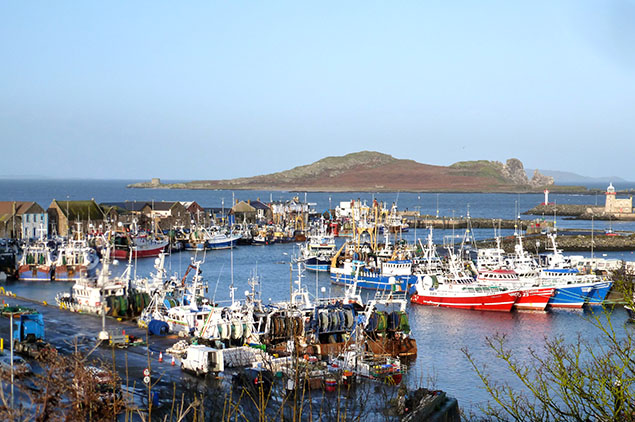 It’s Christmas, and the fishing fleet is safe in port. Howth as it was yesterday afternoon. Photo: W M Nixon
It’s Christmas, and the fishing fleet is safe in port. Howth as it was yesterday afternoon. Photo: W M Nixon

































































